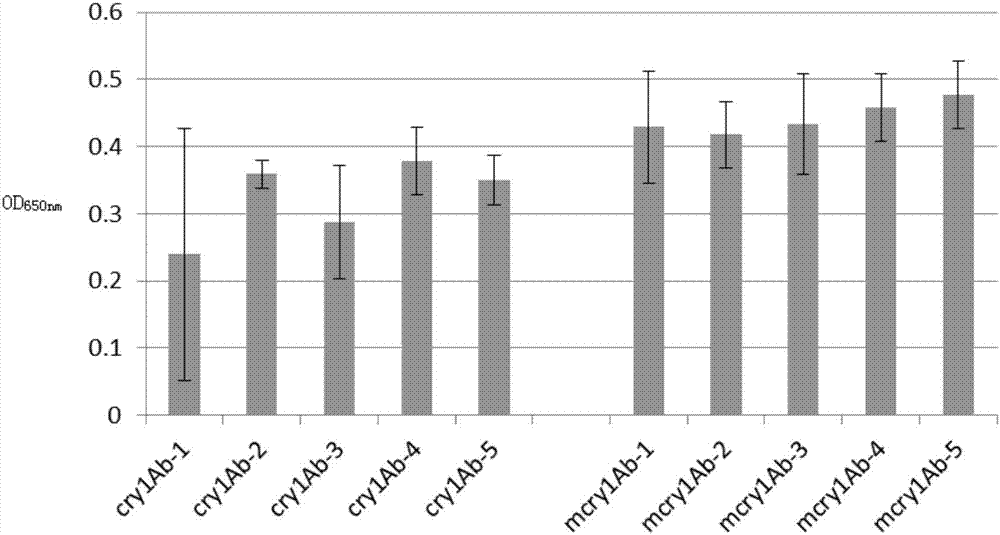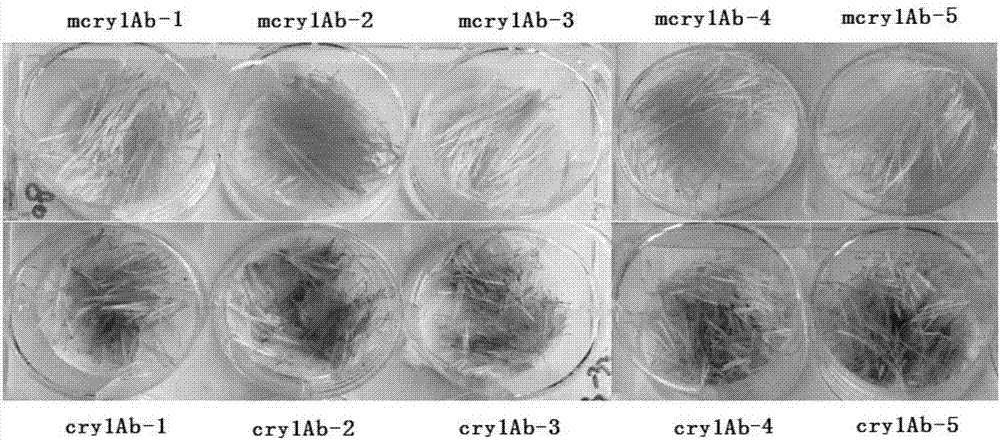Synthetic Bt insecticidal gene mcry1Ab for transgenosis insect-resistant plants
A technology of transgenic plants and transgenic cell lines, applied in the field of biological control, can solve problems such as lack of commercialization
- Summary
- Abstract
- Description
- Claims
- Application Information
AI Technical Summary
Problems solved by technology
Method used
Image
Examples
Embodiment 1
[0078] Embodiment 1, transformation of Cry1Ab gene and acquisition of mCry1Ab gene
[0079] The amino acid sequence of the Cry1Ab protein is shown in sequence 4 in the sequence listing. The nucleotide sequence of the gene encoding the Cry1Ab protein (hereinafter referred to as the Cry1Ab gene) is shown in sequence 3 in the sequence listing.
[0080] The inventors of the present invention carefully analyzed the active region of the Cry1Ab protein, and under the premise of ensuring further improvement of its expression level, modified the gene coding frame and codons of the Cry1Ab protein according to the coding characteristics of monocotyledonous plants. The modified Cry1Ab protein is named mcry1Ab protein. The amino acid sequence of the mcry1Ab protein is shown in sequence 2 in the sequence listing. The nucleotide sequence of the gene encoding the mcry1Ab protein (ie, the modified Cry1Ab gene, hereinafter referred to as the mcry1Ab gene) is shown in sequence 1 in the sequenc...
Embodiment 2
[0085] Example 2, bioassay of mcry1Ab protein to Lepidoptera insects
[0086] 1. In vitro expression and purification of mcry1Ab protein
[0087] The in vitro expression and purification steps of mcry1Ab protein are as follows:
[0088] 1. Artificially synthesize the double-stranded DNA molecule shown in sequence 1 in the sequence listing.
[0089] 2. Ligate the double-stranded DNA molecule synthesized in step 1 with the prokaryotic expression vector pEASY-E1 to obtain the recombinant plasmid pEASY-mcry1Ab.
[0090] The recombinant plasmid pEASY-mcry1Ab was sequenced. Sequencing results show that the recombinant plasmid pEASY-mcry1Ab contains the DNA molecule shown in sequence 1 in the sequence listing, and expresses the mcry1Ab protein shown in sequence 2 in the sequence listing.
[0091] 3. The recombinant plasmid pEASY-mcry1Ab was introduced into Escherichia coli transetta to obtain a recombinant bacterium, which was named transetta-mcry1Ab.
[0092] 4. Take a single cl...
Embodiment 3
[0103] Example 3. Obtaining and identification of insect resistance of transgenic mCry1Ab maize
[0104] 1. Construction of recombinant vector
[0105] The recombinant plasmid pCAMBIA3301+mCry1Ab was constructed and sequenced. According to the sequencing results, the structure of the recombinant plasmid pCAMBIA3301+mCry1Ab is described as follows: replace the small fragment between the recognition sequences of the restriction endonucleases HindIII and BstEII of the vector pCAMBIA3301 with the sequence 5 in the sequence table from the 1st to the 2458th position from the 5' end Double-stranded DNA molecules are shown. The recombinant plasmid pCAMBIA3301+mCry1Ab expresses the mcry1Ab protein shown in Sequence 2 in the Sequence Listing.
[0106] The expression cassette is contained in the recombinant plasmid pCAMBIA3301+mCry1Ab, and the nucleotide sequence of the expression cassette is shown in sequence 5 in the sequence list. In sequence 5 in the sequence listing, the 1st to 5...
PUM
 Login to View More
Login to View More Abstract
Description
Claims
Application Information
 Login to View More
Login to View More - R&D Engineer
- R&D Manager
- IP Professional
- Industry Leading Data Capabilities
- Powerful AI technology
- Patent DNA Extraction
Browse by: Latest US Patents, China's latest patents, Technical Efficacy Thesaurus, Application Domain, Technology Topic, Popular Technical Reports.
© 2024 PatSnap. All rights reserved.Legal|Privacy policy|Modern Slavery Act Transparency Statement|Sitemap|About US| Contact US: help@patsnap.com










